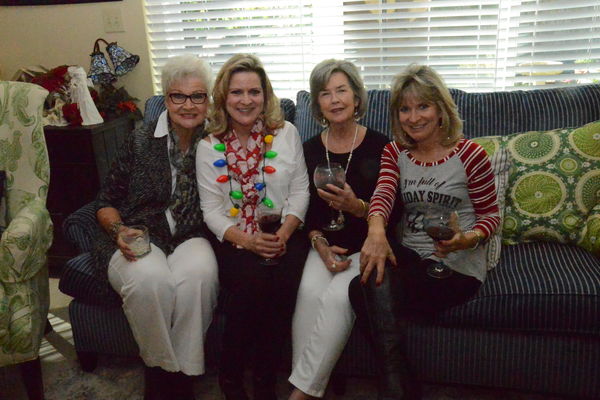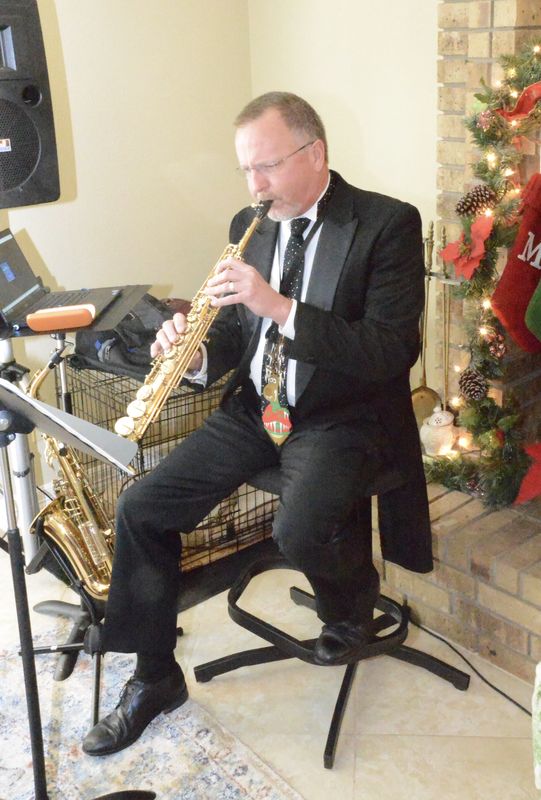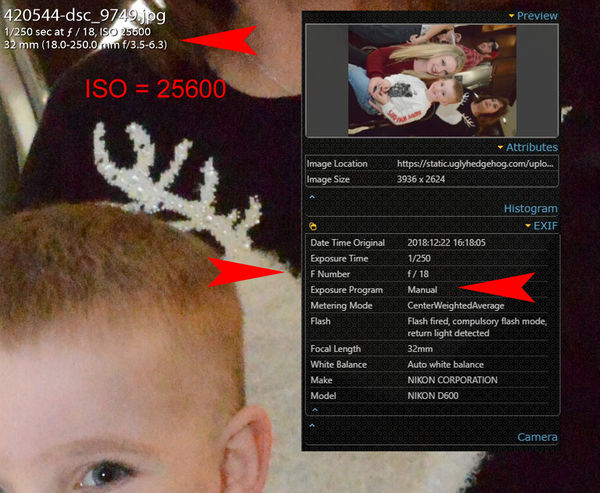why grainy look....not necessarily focus
Dec 24, 2018 11:42:50 #
Why do these photos look grainy..the entire shoot of 75 pictures all looked about the same.. My I phone took better pictures
Nikon D600, Nikon flash, and using a Sigma 50-250, 3.5-6.3 lens…set on aperture priority for a while then set to manual at abut half way through …. have used it many times before with much better results
Nikon D600, Nikon flash, and using a Sigma 50-250, 3.5-6.3 lens…set on aperture priority for a while then set to manual at abut half way through …. have used it many times before with much better results
Dec 24, 2018 11:45:34 #
Dec 24, 2018 11:48:35 #
#3 shows ISO of 25,600. YIKES!! You used 22 mm focal length and f/20. Estimating 10 feet distance, your depth of field is infinity. Note that in addition to aperture setting, depth of field is affected by focal length and distance to subject. f/18 for #1 is also far more than needed. See:
http://www.dofmaster.com/dofjs.html
I see that in your June 18 topic here you used 1/2000 of a second for a non-moving subject. Probably time for a refresher on how exposure works, and the importance of understanding the properties of each of the elements: shutter speed, aperture, ISO.
http://www.dofmaster.com/dofjs.html
I see that in your June 18 topic here you used 1/2000 of a second for a non-moving subject. Probably time for a refresher on how exposure works, and the importance of understanding the properties of each of the elements: shutter speed, aperture, ISO.
Dec 24, 2018 12:01:14 #
Linary
Loc: UK
sumo wrote:
Why do these photos look grainy..the entire shoot of 75 pictures all looked about the same.. My I phone took better pictures
Nikon D600, Nikon flash, and using a Sigma 50-250, 3.5-6.3 lens…set on aperture priority for a while then set to manual at abut half way through …. have used it many times before with much better results
Nikon D600, Nikon flash, and using a Sigma 50-250, 3.5-6.3 lens…set on aperture priority for a while then set to manual at abut half way through …. have used it many times before with much better results
You posted in a previous thread a link to a tutorial on ISO. Your answers lie in that tutorial.
https://www.uglyhedgehog.com/t-397825-1.html#6678921
Dec 24, 2018 12:11:00 #
sumo wrote:
Why do these photos look grainy..the entire shoot of 75 pictures all looked about the same.. My I phone took better pictures
Nikon D600, Nikon flash, and using a Sigma 50-250, 3.5-6.3 lens…set on aperture priority for a while then set to manual at abut half way through …. have used it many times before with much better results
Nikon D600, Nikon flash, and using a Sigma 50-250, 3.5-6.3 lens…set on aperture priority for a while then set to manual at abut half way through …. have used it many times before with much better results
Here is a 7 minute video that should show you how to correct your problem. Hope it helps.
https://youtu.be/S3IQFayyyoU
Dec 24, 2018 12:11:27 #
sumo wrote:
Why do these photos look grainy..the entire shoot of 75 pictures all looked about the same.. My I phone took better pictures
Nikon D600, Nikon flash, and using a Sigma 50-250, 3.5-6.3 lens…set on aperture priority for a while then set to manual at abut half way through …. have used it many times before with much better results
Nikon D600, Nikon flash, and using a Sigma 50-250, 3.5-6.3 lens…set on aperture priority for a while then set to manual at abut half way through …. have used it many times before with much better results
Why in the world would you select MAX ISO and then use a flash????
Recipe for disaster if you don't want digital noise in your images. I recommend you take some lessons and learn the exposure triangle.
Dec 24, 2018 12:29:08 #
Turn off auto ISO....Start with ISO 200 on auto and see if you can hand hold at that speed...if not go with the Lowest ISO you can.. Then reason why you or the camera needs a higher ISO. In certain circumstances you do....but not in all circumstances.
Don't worry.....it is a common error and cameras now have some stupid ISO settings (film had only two or three)
Have fun
Don't worry.....it is a common error and cameras now have some stupid ISO settings (film had only two or three)
Have fun
Dec 24, 2018 12:55:04 #
Have you considered just putting the camera on Auto? Your use of manual and your exposure decisions are the source of your problems. Too high ISO, too small aperture. Your phone is the same as shooting in auto.
Dec 24, 2018 13:20:13 #
Exposure (how bright the photo) depends on 3 things: shutter speed (the longer the shutter is open, the more light collected), the aperture (the wider open, the more light) and ISO which is like gain (the higher, the more light). However, each has other affects. You can get the same exposure with a variety of combos, but the other affects (like noise) will be different.
LEARN THE EXPOSURE TRIANGLE and the other affects adjusting each of the 3 will cause.
On the 3rd photo:
The ISO (25600) is much too high (causing noise) - learn about noise
The shutter speed (1/40 seconds) is open much too long allowing camera motion to blur photo - learn about stopping action
The aperture (f/20) is extremely small requiring the previous 2 to be very high - learn about depth of field
LEARN THE EXPOSURE TRIANGLE and the other affects adjusting each of the 3 will cause.
On the 3rd photo:
The ISO (25600) is much too high (causing noise) - learn about noise
The shutter speed (1/40 seconds) is open much too long allowing camera motion to blur photo - learn about stopping action
The aperture (f/20) is extremely small requiring the previous 2 to be very high - learn about depth of field
Dec 24, 2018 14:38:02 #
Buy yourself a useful Christmas present:
Understanding Exposure
I use it to help teach the Boy Scout Photography Merit Badge.
Understanding Exposure
I use it to help teach the Boy Scout Photography Merit Badge.
Dec 24, 2018 14:48:55 #
Yikes!
The two Canon full frames I have owned do flash at 1/180 (6D) and 1/250 (5DIV) at ISO 400 and flash pictures look great.
You need to change your settings, esp the ISO - way too high - those ISO settings alone will produce "grain"/noise that is out of this world.
The two Canon full frames I have owned do flash at 1/180 (6D) and 1/250 (5DIV) at ISO 400 and flash pictures look great.
You need to change your settings, esp the ISO - way too high - those ISO settings alone will produce "grain"/noise that is out of this world.
Dec 24, 2018 15:00:05 #
PHRubin wrote:
Exposure (how bright the photo) depends on 3 thing... (show quote)
These suggestions are dead on . . . if you are shooting with available light!!!! BUT all wrong if shooting with flash.
Dec 24, 2018 15:04:34 #
Weddingguy wrote:
Please elaborate. How would shooting wider aperture than f/18 or f/20 be wrong? Does it have to do with shutter speed needing to synch, so you're limited with that setting? Please explain more for those of us who rarely use flash.These suggestions are dead on . . . if you are shooting with available light!!!! BUT all wrong if shooting with flash.
Dec 24, 2018 15:46:47 #
Linda From Maine wrote:
Please elaborate. How would shooting wider aperture than f/18 or f/20 be wrong? Are you referring to shutter needing to synch? Please explain more for those of us who rarely use flash.
When using flash there are only TWO camera settings that affect exposure . . . ISO which is generally not an adjustment used from one image to the next, but is set according to the light situation at the moment. For best quality the ISO should be kept as low as possible for all situations.
The only other camera setting that affects exposure is the aperture. At a setting of F/16 or F/20 few flash units would have enough power beyond 5-7 feet.
Some of you are thinking that I have missed the FEC (Flash Exposure Compensation) setting, but that is really more of a flash unit setting than a camera setting.
For wedding and other event photography, where under time pressures, little time is allowed for multiple setting changes and test shots, we have always used settings that allow as much latitude as possible to handle different subject distances, room conditions, lightness or darkness of subjects (think black tuxedos and white wedding gowns).
Most flash units (speed lights) are automatic today, and while using them in TTL, it is unwise to have the camera set at any automatic setting including Auto, Shutter Priority, Aperture Priority, Program, etc. The camera in any auto setting sets the exposure based on the existing light BEFORE the flash fires. Indoors the result is almost always the too high of an ISO setting, aperture wide open, and/or slow shutter speeds as the camera tries to compensate for too little light for a proper exposure. By putting the camera on Manual, the existing (ambient) light is ignored, and the flash does it's own auto setting to achieve correct exposure up to it's power capability. Having both the camera and flash set to automatic confuses both the camera and flash and forces it to go beyond it's exposure analysis capabilities. The main result is inconsistency at best.
I know there are many ways to "skin a cat", but here is how we have been doing it for over a decade of digital wedding coverage, with results of over 95% success on exposure.
ISO 400 on all indoor flash shots . . . dropped to 100 outdoors with bright sun and 200 on cloudy days.
Shutter speed of 1/200 second to prevent camera/subject movement recorded from ambient light
Aperture F/4.5 for one or two subjects . . . moved to F/6.3 for groups and close in of three or more people for greater DOF
Because the flash TTL has latitude limitations, if, with those setting, shots are taken so close that the shot is over exposed . . . or so far away that shots become under exposed (when checked with histogram), we make temporary adjustments using the FEC. I should also add that we have always used Lite-Scoops on our speed lights that seem to disperse the light reducing the sudden drop-off of light. This seems to reduce the critical flash to subject exposure experienced with straight-on flash.
Sorry I couldn't give you an easy one sentence answer to your question. Hope that helps.
Dec 24, 2018 16:09:04 #
I consider myself taken to the woodshed and beaten... guess I didn't know my ISO setting was so high.....
pictures taken the day before were all OK...I have reset all my settings...
I do know slow shutter speed causes blur/out of focus...but I didn't think it would cause a grainy look...I have never had so many grainy looking photos...
have been taking pictures of my bookcase for the past two hours... constantly changing settings...I know the exposure triangle - what is amazing to me is I've been doing this for 60+ years, you think I would have learned something by now...
maybe I am getting too forgetful ...thanks for the feedback...
pictures taken the day before were all OK...I have reset all my settings...
I do know slow shutter speed causes blur/out of focus...but I didn't think it would cause a grainy look...I have never had so many grainy looking photos...
have been taking pictures of my bookcase for the past two hours... constantly changing settings...I know the exposure triangle - what is amazing to me is I've been doing this for 60+ years, you think I would have learned something by now...
maybe I am getting too forgetful ...thanks for the feedback...
If you want to reply, then register here. Registration is free and your account is created instantly, so you can post right away.











